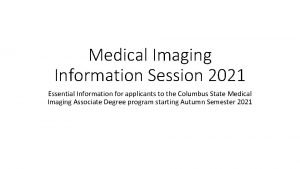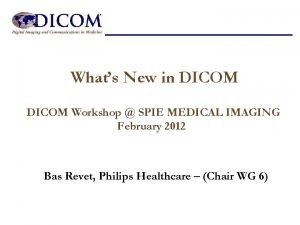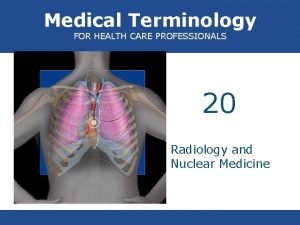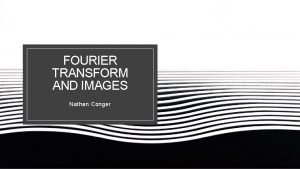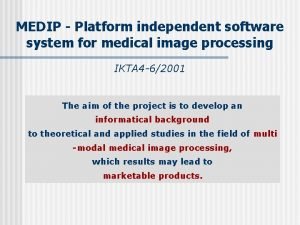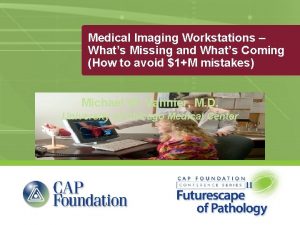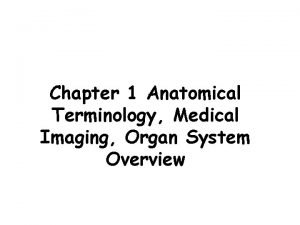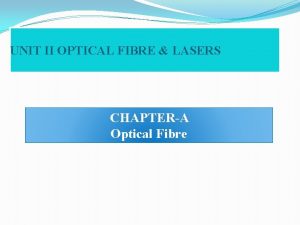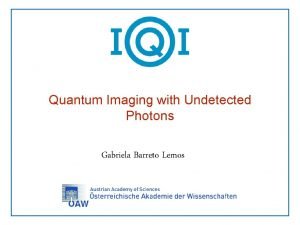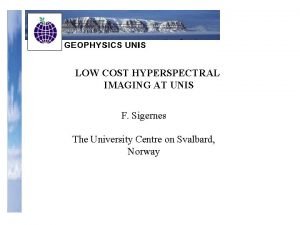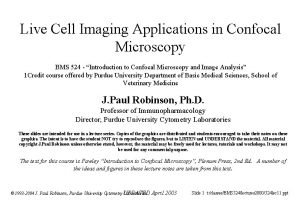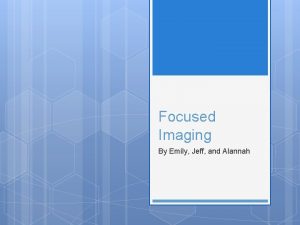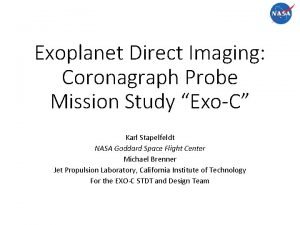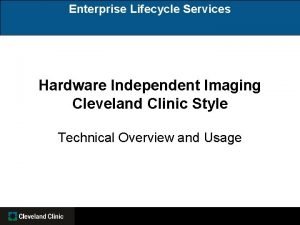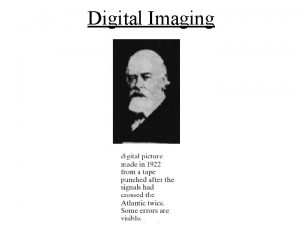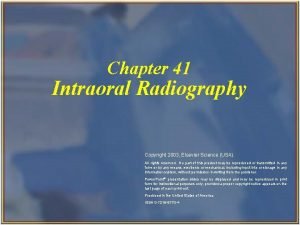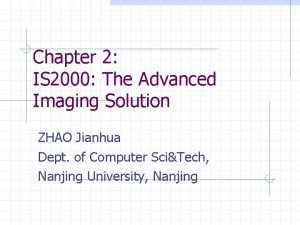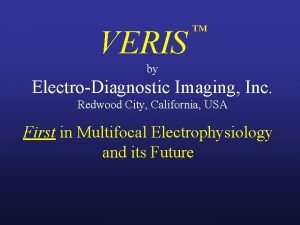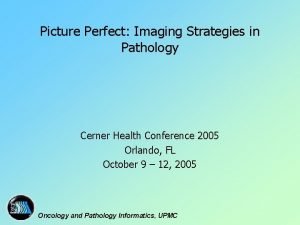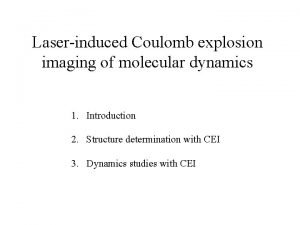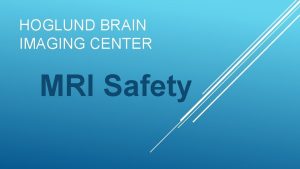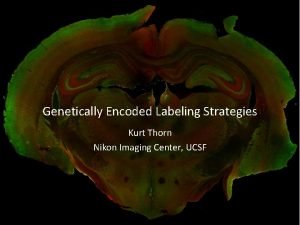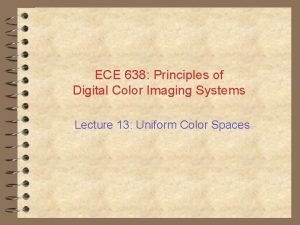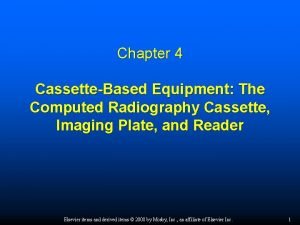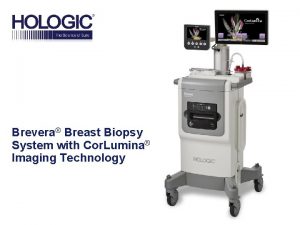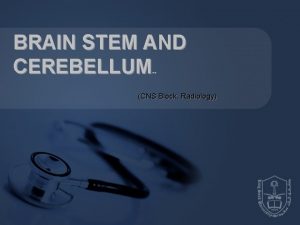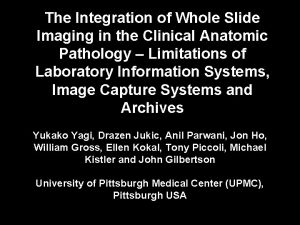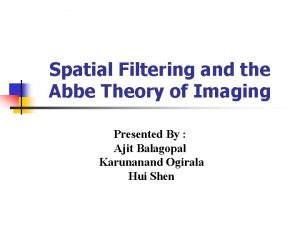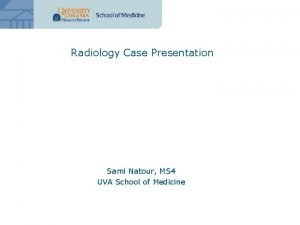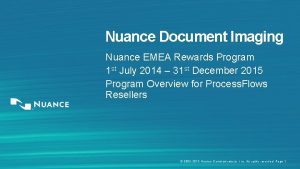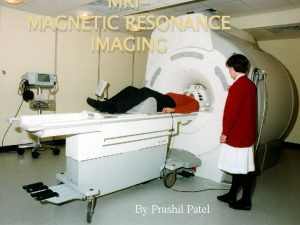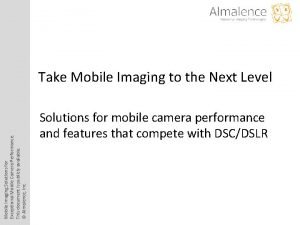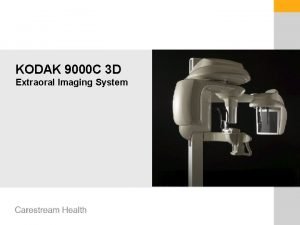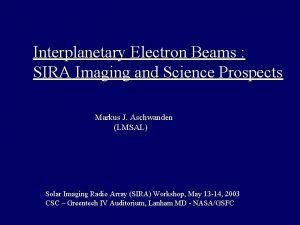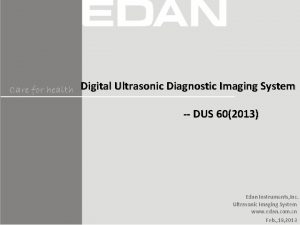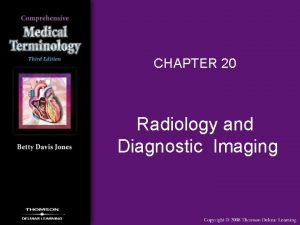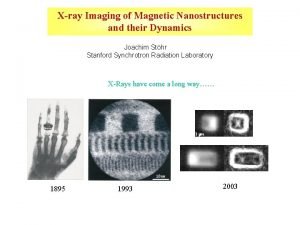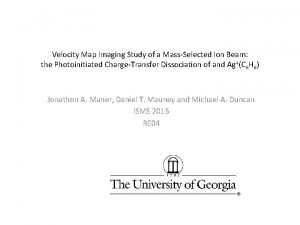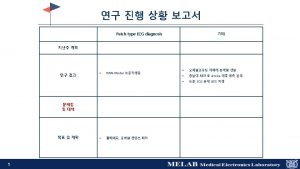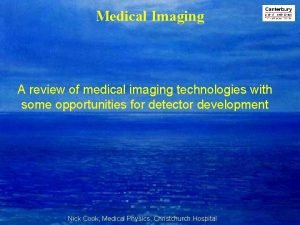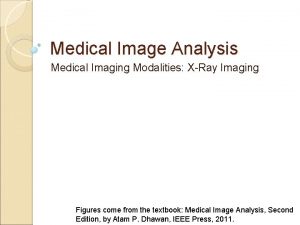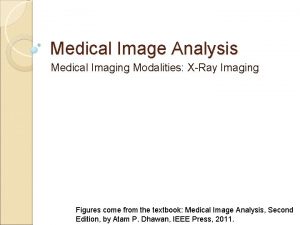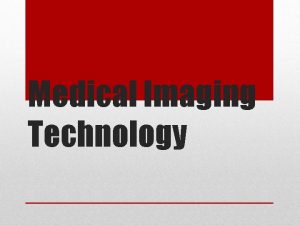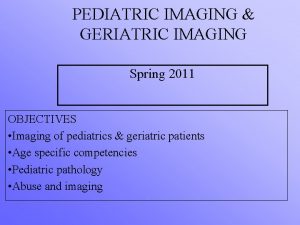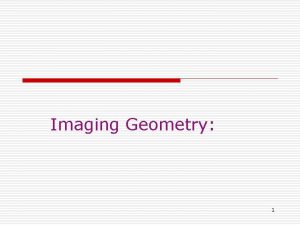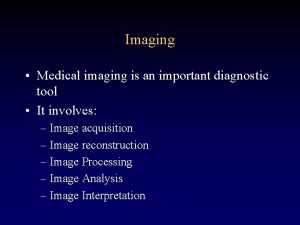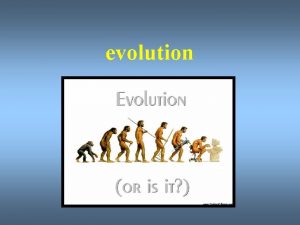Medical Imaging Index Medical Imaging Evolution of Medical
























































- Slides: 56

Medical Imaging

Index • Medical Imaging • Evolution of Medical Imaging • Types of Medical Imaging ▫ ▫ ▫ ▫ ▫ Medical Radiography X-Ray Imaging Nuclear Imaging Bone Densitometry Magnetic Resonance Imaging (MRI) Ultrasound Neuroprosthetics Computed Tomography (CT) Fluoroscopy Echocardiography ▫ Digital Vascular Imaging ▫ Positron Emission Tomography (PET) and Radionuclide Scanning

Medical Imaging • Medical imaging is a discipline within the medical field which involves the use of technology to take images of the inside of the human body. These images are used in diagnostics, as teaching tools, and in routine healthcare for a variety of conditions. Medical Imaging • Medical imaging is sometimes referred to as diagnostic imaging, because it is frequently used to help doctors arrive at a diagnosis, and there a number of different types of technology used in medical imaging. The goal of medical imaging is to provide a picture of the inside of the body in a way which is as non-invasive as possible. An imaging study can be used to identify unusual things inside the body, such as broken bones, tumors, leaking blood vessels, and so forth. One of the most famous types of diagnostic imaging is the x-ray, which uses radiation to take a static image of a specific area of the body.

Evolution of Medical Imaging • Medical imaging began with the discovery of XRays by Wilhelm Conrad Röntgen in 1895 and his work showing that these rays could be used to peer inside the body and visualize bony structures. From this Nobel Prize winning discovery to the modern day, there are now many means by which the internal structures of the body can be assessed without the need for cutting it open.

Measurement and recording techniques which are not primarily designed to produce images, such as electroencephalography (EEG), magneto encephalography (MEG), electrocardiography (ECG) and others, but which produce data susceptible to be represented as maps (i. e. containing positional information), can be seen as forms of medical imaging.

Types of Medical Imaging ▫ ▫ ▫ ▫ ▫ Medical Radiography X-Ray Imaging Nuclear Imaging Bone Densitometry Magnetic Resonance Imaging (MRI) Ultrasound Computed Tomography (CT) Fluoroscopy Echocardiography Types of Medical Imaging ▫ Digital Vascular Imaging ▫ Positron Emission Tomography (PET) and Radionuclide Scanning

Medical Radiography • During a radiographic procedure, an x-ray beam is passed through the body. Medical Radiography • A portion of the x-rays are absorbed or scattered by the internal structure and the remaining x-ray pattern is transmitted to a detector so that an image may be recorded for later evaluation. • The recoding of the pattern may occur on film or through electronic means Medical Radiography is considered a noninvasive procedure, which means that the process of acquiring a medical image does not penetrate the skin.

Radiography is used in many types of examinations and procedures where a record of a static image is desired. Some examples include ▫ Dental examination ▫ Verification of correct placement of surgical markers prior to invasive procedures ▫ Mammography ▫ Orthopedic evaluations ▫ Spot film or recording during fluoroscopy ▫ Chiropractic examinations

Digital Radiography MATRIX

X-Ray Imaging • X-rays are waves that have a relatively high frequency along the electromagnetic spectrum. They are absorbed or transmitted by different body tissues in varying amounts, producing different shades of black and white on an x-ray image. X-Ray Imaging The basic type of x-ray imaging is plain radiography. This involves an x-ray machine aimed at the patient's body with a recording plate positioned behind the region of interest. Once the machine delivers its radiation, the image is captured on the plate. This allows a physician to assess the bones for fractures, abdomen In general, bone appears white, soft tissue appears the gray, and air for bowelblack. obstruction, and the breasts for signs of cancer appears (mammography), among other applications.

Nuclear Imaging • Nuclear imaging is unique in that the means of visualization are not external waves delivered to the body. Rather, electromagnetic waves are emitted from within. In general, a radioactive marker is introduced into the patient's bloodstream and accumulates in the organ of interest. The marker gives off gamma rays that are detected by a special camera and processed into images by a computer. Nuclear Imaging This type of imaging is also unique in that nuclear medicine physicians, not radiologists, are the ones who interpret nuclear imaging studies. Applications of nuclear imaging include perfusion of the heart, activity of the thyroid gland, and late-stage cancer.



Nuclear medicine images

• Bone density scanning is a form of X-ray Bone technology used. Densitometry to measure a person’s bone loss.

Bone densitometry is most often used to diagnose osteoporosis, a condition that causes a gradual loss of calcium resulting in thinner and more fragile bones. Bone densitometry is also a preventative tool that tracks the effect of treatment for various conditions that cause bone loss.

Image Digitization Transducer Digitization with Matrix Arraying Scheme Windowing Inversion Image Sharpening

MRI Scanners • MRI scanners, like X-rays and CT scanners, are basically machines doctors use to take pictures of your insides so that they can figure out what’s ailing you. Magnetic Resonance Imaging • But MRI doesn’t involve ionizing radiation, as do Xrays and CT scans. Rather, MRI takes advantage of something you have plenty of in your body: water. It is far more flexible than X-rays and CT scans, and can generate three dimensional images in any orientation and at any depth in the body.

MRI- SIGNAL FROM DETECTORS: ANALOG

Residual Tumor Detection 1. Pre-opt MRI of tumor 2. Intraoperative MRI, residual tumor 3. Post-opt, no tumor

Ultrasound Imaging • Ultrasound imaging uses high-frequency sound waves to produce detailed images of internal structures of the body. Ultra Sound Imaging • Ultrasound imaging is used by physicians to get valuable information that will help them when it comes to diagnosing certain types of illnesses. • One such use is to determine the blood flow in a patients blood vessels. One drawback of ultrasound imaging is the fact that sound does not travel well through bone.

• Ultrasound is produced and detected with a transducer, composed of one or more ceramic elements with electromechanical (piezoelectric) properties. The ceramic element converts electrical energy into mechanical energy to produce ultrasound and mechanical energy into electrical energy for ultrasound detection.

• Over the past several decades, the transducer assembly has evolved considerably in design, function, and capability, from a single-element resonance crystal to a broadband transducer array of hundreds of individual elements. ▫ A simple single-element, plane-piston source transducer has major components including the �Piezoelectric material �Marching layer �Backing block �Acoustic absorber �Insulating cover �Sensor electrode �Transducer housing


Characteristics of Diagnostic Ultrasound • Non-invasive • Safe (under regulations) • Real-time • Reflection mode (similar to RADAR) • Blood flow imaging • Access • Portable • Body type dependent

Function Modes • A-mode (A-scan, 1 D). • B-mode (Gray scale, 2 D). • 3 D ultrasound. • M-mode (motion) • Color Doppler (2 D, blood flow). • Spectral Doppler (localized, blood flow). • Audio Doppler.

Generic Ultrasonic Imaging System Transmitter –Arbitrary waveform. –Programmable transmit voltage. –Arbitrary firing sequence. –Programmable apodization, delay Receiver –Programmable apodization, delay control and frequency control. –Arbitrary receive direction. • Image processing: –Pre-detection filtering. –Post-detection filtering. • Full gain correction: analog and digital. • Scan converter: various scan format.

Image Data Acquisition c. f. Bushberg, et al. The Essential Physics of Medical Imaging, 2 nd ed. , p. 501.

Ultrasound • Heart and blood vessels, incl. the abdominal aorta and its major branches • Liver • Gallbladder • Spleen • Pancreas • Kidneys • Bladder • Eyes • Thyroid and parathyroid glands


Image Digitization - ADC Scanning Sampling Quantization

Ultrasound • Ultrasound waves do not pass through air; therefore an evaluation of the stomach, small intestine and large intestine may be limited. Intestinal gas may also prevent visualization of deeper structures such as the pancreas and aorta. • Patients who are obese are more difficult to image because tissue attenuates (weakens) the sound waves as they pass deeper into the body. Ultrasound has difficulty penetrating bone and therefore can only see the outer surface of bony structures and not what lies within.



Image Manipulation WINDOWING INVERSION IMAGE SHARPENING


Windowing

Image Inversion


Image Sharpening

Neuroprosthetics

Computed Tomography is a form of medical Computed imaging using tomography that is created by computer processing. CT’s can be used to generate three-dimensional images of the inside of the human body. It does this by taking multiple twodimensional X-ray images around a single axis. This data can then be manipulated to form an image of different body structures.

Computed Tomography (CT) is a powerful nondestructive evaluation (NDE) technique for producing 2 -D and 3 -D cross-sectional images of an object from flat X-ray images. Characteristics of the internal structure of an object such as dimensions, shape, internal defects, and density are readily available from CT images.

• Unlike conventional radiography, in CT the patient lies on a couch that moves through into the imaging gantry housing the x-ray tube and an array of specially designed "detectors". • Depending upon the system the gantry rotates for either one revolution around the patient or continuously in order for the detector array to record the intensity of the remnant x-ray beam. These recordings are then computer processed to produce images never before thought possible. • CT on the other hand reconstructs images in a variety of body planes the most usual being the axial or cross sectional plane. • Because of the large range of the CT number scale and the fact that the image is digital, it is possible to manipulate the display to show the underlying soft tissues with enhanced contrast as well as the bony structures. Scanners today are capable of gathering even more data about the body structure in a time span that is measured in seconds thereby enhancing its clinical usefulness.

Why it is performed CT rapidly creates detailed pictures of the body, including the brain, chest, spine, and abdomen. The test may be used to Diagnose an infection Guide a surgeon to the right area during a biopsy Identify masses and tumors, including cancer Study blood vessels

Risks • Being exposed to radiation • Allergic reaction to contrast dye • CT scans do expose you to more radiation than regular x-rays. Having many x-rays or CT scans over time may increase your risk for cancer

BASIC DATA AQUSITION SCHEME IN CT ANALOG ADC

Fluoroscopy • If a doctor needs real-time moving images of internal bodily structures, then they will use an Fluoroscopy imaging technique called fluoroscopy. • The process of fluoroscopy consists of using a radiation and a fluorescent screen. This form of imaging exposes the patient to extremely high forms of ionized radiation.

Echocardiography • An echocardiography is a medical imaging procedure that uses sound waves to create a moving picture of an organ, usually the heart. Echocardiography • Doctors use it because it gives a detailed picture and exposes the patient to zero radiation. • An echocardiogram enables the doctor to see the heart beating, rather than just looking at a picture of the heart. It also provides a detailed moving image of the heart valves that provide even more useful information to the doctor when attempting to diagnose an illness.

Types • • • Transthoracic Echocardiography Stress Echocardiography Trans-esophageal Echocardiography Fetal Echocardiography Three-Dimensional Echocardiography

Digital Vascular Imaging • This is an imaging modality that utilizes the Digital Imaging technology Vascular of digital fluoroscopy and additional equipment and computer systems to image the blood vessels (arteries and veins) of the human body.

Positron Emission Tomography(PET) and Radionuclide Scanning • Another means of imaging the inside of the human body is to inject chemicals such as glucose, which are routinely used by cells, and to label them with short-lived radioactive elements. Positron Emission Tomography(PET) and Radionuclide Scanning • In positron emission tomography, a radiopharmaceutical compound is injected which can be “seen” by specialized detectors built into the scanner. • As the radiopharmaceutical undergoes radioactive decay it emits positrons which lead to molecular actions that can be detected by the scanner. This method can measure the metabolic activity of specific tissues or regions of tissues as well as to assess the metabolic activity and spread of cancers, especially when coupled with coincident CT scanning as is the most common approach used today.

Biomedical Engineers are expected to have employment growth of 72 percent over the next decade, much faster than the average for all occupations. Innovations in medical imaging continue to revolutionize the field of medicine. The advances that have been made are allowing physicians to not only see inside the body with greater clarity, but it is also providing them with the ability to see how certain organs are functioning. The field of medical imaging will continue to provide valuable information that will help all aspects of a patients care.


References • http: //www. med. monash. edu. au/radiography/geninfo/index. html • http: //www. wisegeek. com/what-is-medical-imaging. htm • http: //www. vumc. com/afdelingen/imagingcenter/economic_impact/medic al_imaging/ • http: //anthony-lee. suite 101. com/types-of-medical-imaging-a 85622 • http: //www. onlinenursingprograms. com/resources/a-guide-on-the-typesof-medical-imaging/

 Frc control system
Frc control system Ohiohealth berger hospital mammography circleville
Ohiohealth berger hospital mammography circleville Spie
Spie Medical terminology for radiology
Medical terminology for radiology Fourier series pictures
Fourier series pictures Medical imaging software
Medical imaging software Conclusion of marginalization
Conclusion of marginalization Forearm medical term
Forearm medical term Diff between step index and graded index fiber
Diff between step index and graded index fiber Primary index is dense or sparse
Primary index is dense or sparse Eryhtema
Eryhtema Pqli advantages and disadvantages
Pqli advantages and disadvantages Fibers
Fibers Simpson's diversity index calculator
Simpson's diversity index calculator Consistency limit test
Consistency limit test Clustered index và non clustered index
Clustered index và non clustered index Service host windows image acquisition
Service host windows image acquisition Quantum imaging with undetected photons
Quantum imaging with undetected photons Affordable hyperspectral imaging
Affordable hyperspectral imaging Live cell imaging applications
Live cell imaging applications Salt for concave mirrors
Salt for concave mirrors Focused imaging learning
Focused imaging learning Direct imaging subsystem
Direct imaging subsystem Hardware agnostic imaging
Hardware agnostic imaging Digital image definition
Digital image definition Digital imaging artist
Digital imaging artist Windows architecture
Windows architecture Too little vertical angulation results in images that are
Too little vertical angulation results in images that are Is2000 the advanced imaging solution
Is2000 the advanced imaging solution Imaging near redwood city
Imaging near redwood city Picture perfect imaging
Picture perfect imaging Nuclear imaging techniques
Nuclear imaging techniques Dinamics
Dinamics Princeton iac
Princeton iac Safetymri
Safetymri Global imaging systems inc
Global imaging systems inc Ucsf nikon imaging center
Ucsf nikon imaging center Chapter 42 extraoral imaging
Chapter 42 extraoral imaging Digital color imaging
Digital color imaging Bi rads
Bi rads X ray cassette construction
X ray cassette construction Corlumina imaging hologic
Corlumina imaging hologic Block imaging
Block imaging Roborio imaging tool
Roborio imaging tool Nsi2000
Nsi2000 Whole slide imaging
Whole slide imaging Abbe imaging experiment
Abbe imaging experiment Sami natour
Sami natour Nuance document imaging
Nuance document imaging Diagnostic imaging
Diagnostic imaging Almalence super resolution
Almalence super resolution Kodak 9000 extraoral imaging system
Kodak 9000 extraoral imaging system Sirafen
Sirafen Digital ultrasonic diagnostic imaging system
Digital ultrasonic diagnostic imaging system Rah diagnostic imaging
Rah diagnostic imaging X-ray imaging
X-ray imaging Velocity map imaging
Velocity map imaging

